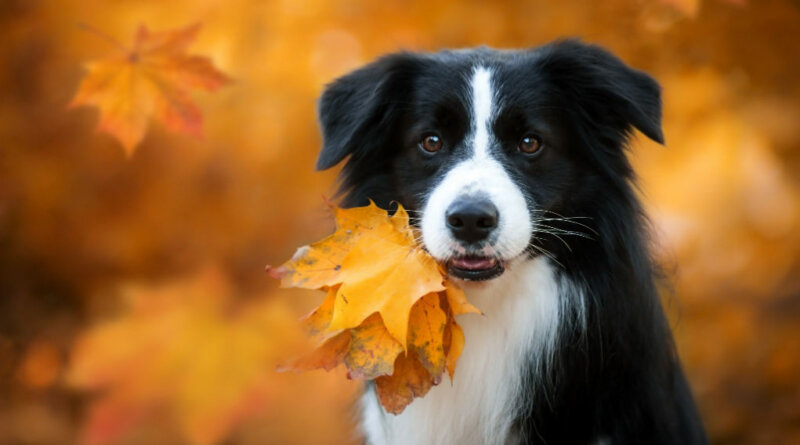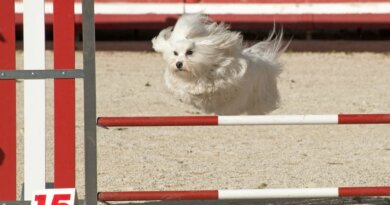19+ Possible Autumn Dangers for Dogs – Top Dog Tips
Just like any other season, there are Autumn dangers for dogs that fur parents have to look out for.
Not only does the cold, crisp weather can bring colds to our pets (yes, dogs and cats catch colds too!), but there are also many things associated with the fall season that can potentially bring them harm.
Just as we prepare our thick, fuzzy blankets, warm jackets and sweaters, and apple ciders, we should also prepare autumn safety measures to protect our dogs from any possible threat to their health.
In this article, we listed down all the possible dangers to our dogs this Autumn season, from the most obvious to the most surprising and unexpected ones!
Autumn Dangers for Dogs: What Are They?
The start of the chilly season during autumn can cause harm to our dogs if we are not vigilant enough.
Apart from the toxins and allergens that are present during the fall season, a lot of wild animals, even the small and seemingly harmless ones are also on high alert during this time of the year.
Not only do they bring the kind of threat you’re probably thinking of right now, but they can also cause infection or diseases that can be passed along to dogs.
The things we use inside the house to keep us warm and comfortable may also be dangerous around our pets, especially if they’re not attended to.
Possible Autumn Dangers for Dogs
Check out our comprehensive list of 19 possible autumn dangers for dogs that can either happen to them caused by the change in season or by the things that may just be inside your house or in your backyard!
Darker and Longer Nights
Although dogs generally have a good sense of direction, you’ll still never know what might be lurking in the background while enjoying your early mornings or nightly walks.
A lot of accidents happen in the dark—you’ll just never be certain what might happen!
Make sure to dress your dog in appropriate outfits (reflective vests, LED harnesses, or LED dog collars) to easily spot him.
If he has a microchip, make sure that it’s also updated with all your information in case he gets lost in the dark.
Seasonal Allergies
Although summertime is the most itch-fest season of the year, autumn also has its own fair share of allergens for dogs.
Mold, pollen, ragweed, dust, and grass are some of the common culprits of fall allergies in dogs.
If your dog suddenly develops rashes and is scratching excessively, sneezing, or has watery eyes and nose discharge, ask your vet to know what might be the trigger and how to treat it.
Don’t worry too much, though, as allergies in dogs are quite manageable.
Seasonal Canine Illness (SCI)
This rare illness is considered a mystery even to experts because no one knows what causes it exactly, except that it always happens during the fall season.
It’s also linked to woodland areas, where dogs start showing symptoms 24 to 72 hours after walking in woodland.
Some notable signs of Seasonal Canine Illness are vomiting, diarrhea, and general tiredness.
However, there are a lot of conditions that may cause these symptoms so visiting your veterinarian is a must for a proper diagnosis.
This is important because SCI can be quite dangerous if not immediately taken care of. There are known cases of dogs that didn’t survive because of this.
Luckily, according to the research conducted by Animal Health Trust, there has been a decline in SCI cases since 2010. But still, we can never be too sure!
Alabama Rot
Another rare but potentially life-threatening disease is Alabama Rot.
Just like the SCI, no one also knows the cause of Alabama Rot but it’s mainly associated with walking in muddy places.
Symptoms first appear as marks, sores, or ulcers on the legs and paws. If untreated, it could later cause problems with blood vessels in the skin and kidneys.
If it’s too impossible to keep your dog away from muddy areas, just make sure to wash and dry them thoroughly after their muddy session.
Acorns, Fallen Fruits, and Leaves
Any fallen things on the ground may seem harmless in the beginning, but in truth, they may contain substances that are highly toxic for dogs.
Acorns, for example. They contain tannins that may cause an upset stomach and eventually, could cause kidney and liver failure. ‘
Just beware of green acorns as they have more tannins than brown ones!
Trees also start dropping their fruits during this season, and if eaten by our pets, fermented and moldy fallen fruits can also cause discomfort.
Also, fruit seeds, pips, and fruit stones also contain toxins that make dogs ill.
While it’s cute seeing our dogs playing on a pile of dried leaves, fallen leaves also develop molds and bacteria that, when ingested, can lead to serious gastrointestinal problems in dogs.
Conkers/ Horse Chestnut Tree
Another common seed during autumn is Conker, a hard nut-like seed from the horse chestnut tree.
They are particularly bad for dogs because of the poison they contain (even the leaves from the tree!) called aesculin. In rare cases, it can be deadly too.
Symptoms of conker poisoning may include vomiting with blood, diarrhea, drooling, tummy pain, increased thirst, and reduced appetite.
Not only that, but conkers are also large and hard and may cause your dog to choke, or block his stomach and gut.
Wild Mushrooms, Toadstools, Fungi
While there are plenty of mushrooms that are generally safe to eat for dogs and humans, wild mushrooms, toadstools, and any suspicious fungi that you see on your walks should be avoided at all costs.
While some toxic mushrooms can only cause upset stomachs at most, there are other kinds that could be poisonous and take effect in days, weeks, or in an instant.
If your dog accidentally ingests one, take her immediately to the veterinarian. Keep a clear mind and don’t panic!
Take a photo of the mushroom and take note of the environment where it’s growing.
This will help the experts identify what type of mushroom has been eaten and how to treat it immediately.
Fleas, Ticks, Parasites
These parasites are a year-round problem for most dogs and their owners, but fleas and ticks are actually more active during autumn. (Yes, they don’t die in cold weather just like we thought!)
It’s possible to pick up these unwanted hitchhikers on your outdoor walks from other animals. Or sometimes, they can just be hiding in the fallen leaves, who knows!
Apart from causing relentless scratching, fleas and ticks can also be the transporter of different diseases. That’s why it’s important to make sure your dog is free of them once you got home!
Check out our article on The Ultimate Dog Fleas and Ticks Survival Guide.
Wildlife
Wild animals are also busy preparing for the cold weather so they are usually on heightened alert during this season.
Be careful on your hikes as you may encounter some wild animals like snakes that could possibly perceive your intrusion as a threat. Their venomous bite is equally lethal for dogs and humans alike.
But you shouldn’t only be wary of large animals, as the smaller ones can also be dangerous too. ‘[
Not only that they can get aggressive, but they may also be carriers of different diseases.
Just always be aware of the native animals in your area.
Fireworks and Sparklers
Autumn season is also a time for celebration, and with that comes the fireworks and sparklers.
But be wary especially if you have a dog in the family—they’ll definitely get stressed with all the noise, especially with their super hearing ability!
Not only that but spent fireworks and sparklers also contain dangerous chemicals that if left lying around dogs, can cause breathing problems, blood in stool, and tummy pain among others.
Glow Sticks and Luminous Bracelets
Unlike fireworks and sparklers, glow sticks and luminous bracelets can be quite attractive to our pets. They’re pretty and colorful but without the noise!
However, the liquid inside that makes them glow is irritant and toxic both for pets and humans. It can cause stomach aches and froth in the mouth if ingested.
Halloween Horrors
Don’t get us wrong, our pets can certainly join in on the fun too in this spooky holiday. But there are elements in our Halloween celebration that might just be too distressing for them.
Case in point, those spooky Halloween costumes, noisy trick-or-treaters, and house decorations.
Those small figurines or creepy details you put out could be a choking hazard for them.
Plus, Halloween can also mean gatherings and strange visitors. For unsocialized pups, this could mean horror!
And don’t forget the Halloween treats, too. While we can enjoy them as much as we want, chocolates, sweets, raisins, and other candies are a no-no for dogs.
Chocolates contain theobromine which is absolutely poisonous for them, sweets have xylitol (another toxic substance) and raisins and grapes have a still unknown toxin.
Planting Spring Bulbs and Other Decorative Plants
Maintaining a beautiful garden can be one way of coping with stress, but make sure that what you’re planting is actually safe for dogs!
Spring bulbs (especially of Daffodils, Tulips, and Crocus) have concentrated allergens and toxins that may be harmful to them.
At the same time, autumn flowering plants like Chrysanthemum and Cyclamens can also cause vomiting, diarrhea, seizures, and death when accidentally ingested.
Rat and Mouse Poison
You’re probably doubling up these measures, especially since Mickey and his friends may be inviting themselves to your house unpermitted because of the cold season.
However, be careful as rodenticides can also be attractive to your dog, too.
Always make sure that you put these pesticides in places where your pet can’t reach them to avoid any accidents from happening.
Antifreeze
During the cold weather, you can’t forget about maintaining your car.
But some chemicals that we’re using are highly toxic to our dogs. (And by highly toxic, we mean instant death!)
Antifreeze, for example, is actually sweet and palatable for our dogs. However, just a small amount of it can cause serious kidney damage.
Your dog will probably appear “drunk” right after drinking it before the worst thing can happen.
Mothballs
As you unpacked your blankets and sweater-weather clothes, make sure that there are no stray mothballs lying around the house for your dog to find.
Mothballs contain a high concentration of insecticides. If ingested, it can cause anemia, vomiting, lethargy, and liver and kidney damage.
They can also be choking hazards if swallowed.
Candle
Lighting candles can be relaxing and decorative too during this time of the year. But keeping one burning unsupervised is dangerous when you have a curious pup around.
Not only your dog can hurt himself, but he can also accidentally knock it down and burn the house. You can just never be sure, you know.
Also, some candles release carcinogens and toxins while burning. They’re also potential dangers for your pooch even only when inhaled.
Heater
The same goes with any kind of heater you have in the house during autumn, your dog can hurt himself when he gets too close to it.
Fireplaces or space heaters should always be covered to prevent any over-excited pooch from burning itself.
Joint Pain
Dogs, especially senior ones, can also experience joint pains when it’s chilly outside. Make sure they are warm and comfortable enough to prevent any joint pains from happening.
Autumn Safety Tips for Dogs
Just by reading the possible autumn dangers for dogs above, you probably already got a clear picture of how to keep your precious pooch safe from harm.
But just a quick rundown, here are 10 tips to keep them safe this chilly season.
- Keep your dog warm
- Make sure your dog can be seen all the time
- Preventative care is important!
- Steer clear from antifreeze, rodenticides, and any other toxic materials for dogs
- Be careful with holiday treats
- Watch out for the Halloween horrors!
- Get your pet microchipped
- Keep an eye out for wildlife
- Consider joint supplements
- Just cuddle with them on the couch!
FAQs on Autumn Dangers for Dogs
Do dogs like fall weather?
Actually, they do! Dogs like fall weather not only because of the fun activities they can do but because they can also regulate their body temperature better in cold than in the hot seasons.
Cooler temperatures are definitely one of the reasons why dogs love the fall weather.
Can change in weather make dogs sick?
Regardless of how much they love the cool temperature, a change in weather can also make dogs sick.
Their respiratory system plays a big role in keeping them warm so when the weather gets too cold, it can constrict (just like in us humans!) Infections can create symptoms like a cold, such as sneezing and nose congestion.
Also, just like what we have discussed above, there are several mysterious illnesses dogs can get during autumn (like the SCI and Alabama Rot.)
How cold is too cold for dogs?
Dogs can generally regulate their body heat (also thanks to their fur!) but extremely low temperatures can be too cold for dogs, too.
45° F or 7° C may be unsafe for small to medium size dogs with thin coats, but large breeds with heavier, double coats should be okay.
However, if the weather further dropped to 32° F or 0° C, you should already pay close attention to their well-being, especially pups, senior dogs, or dogs with preexisting conditions.
Autumn Dangers for Dogs – Final Thoughts
Autumn dangers for dogs are ever-present, as they do in other seasons too!
But this doesn’t mean you shouldn’t let your pup enjoy this fall weather. You just gotta be extra cautious to make sure that no harm will fall on your furry little friend.
There are, after all, available autumn safety tips for dogs that can help you take care of them.
And if you want your pooch cozy and safe, why not just enjoy a movie marathon featuring dogs in Halloween movies? Check out our movie recommendations below for your binge-watching session this spooky season.
READ NEXT: Dogs in Halloween Movies (Scariest and Most Adorable Ones!)
Related










